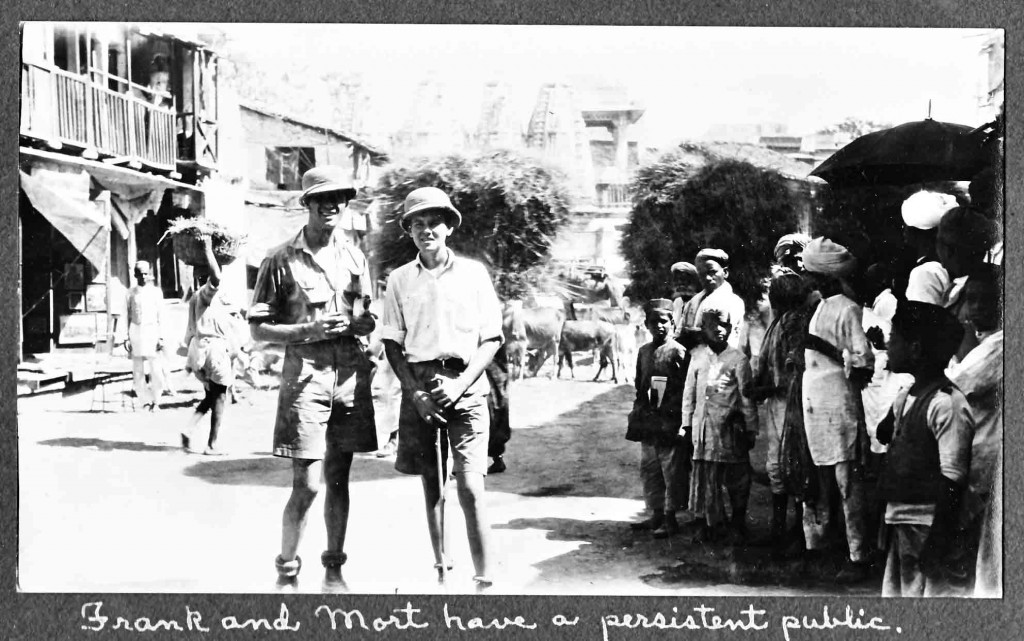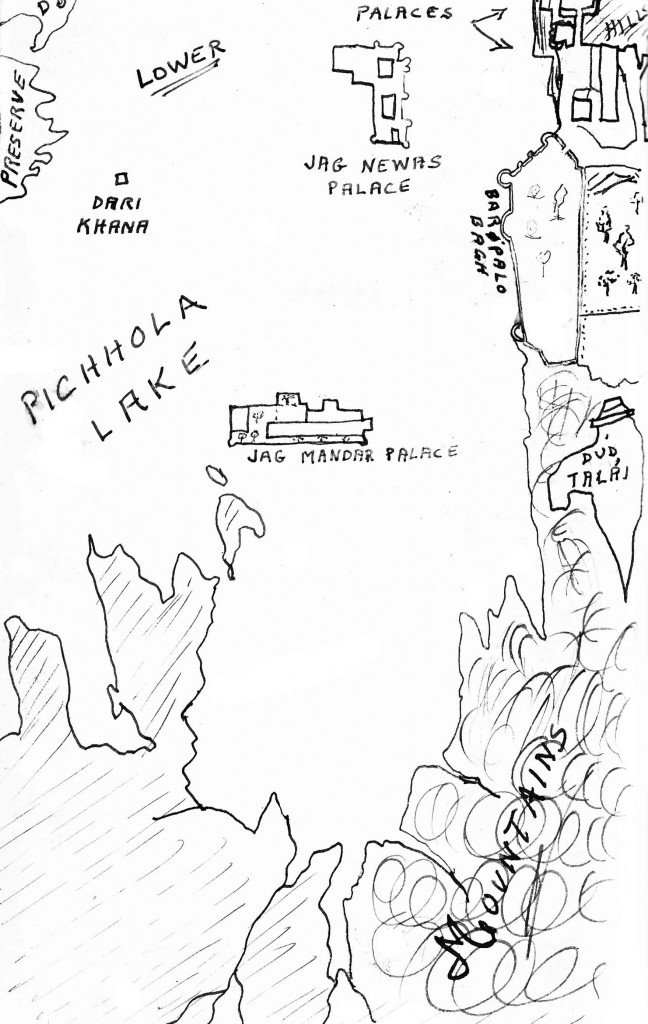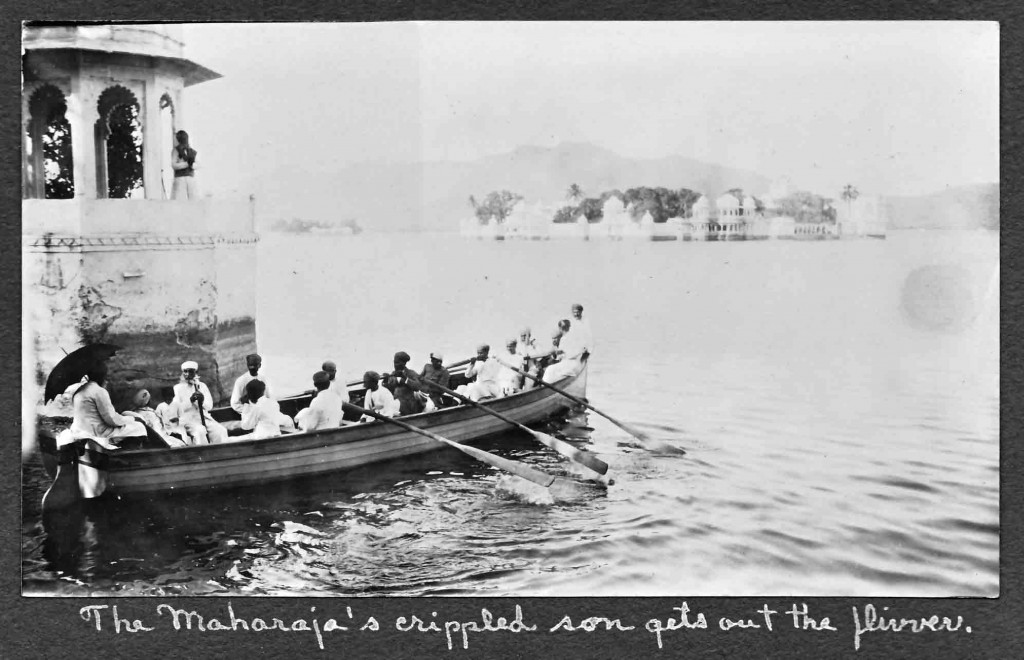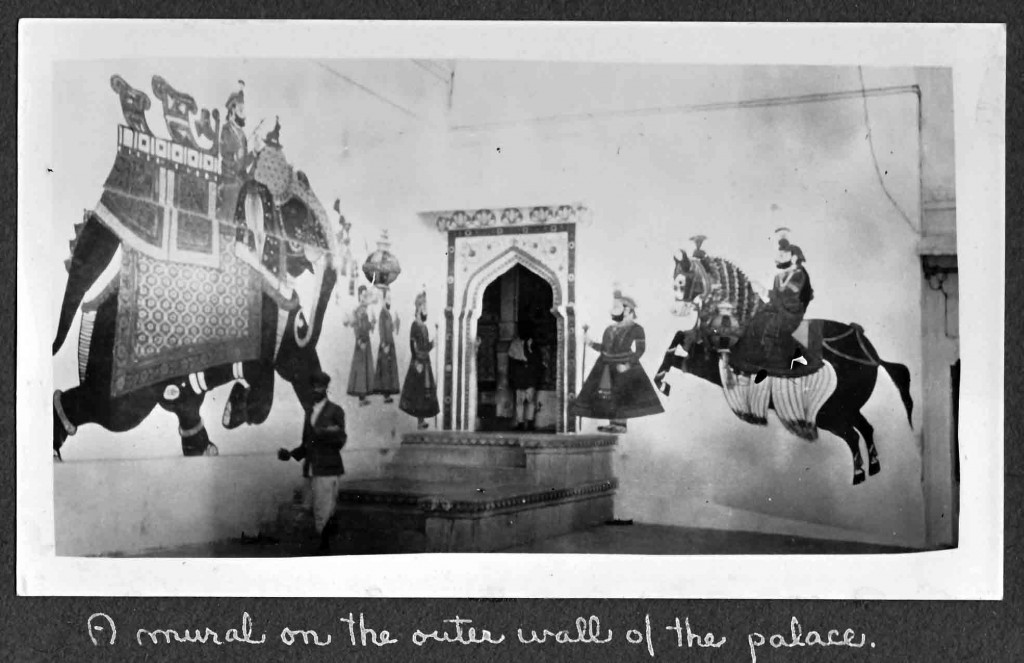 Friday, April 26, 1929
Friday, April 26, 1929
Woke up at 8:30, had a nice cold bath, then a big breakfast. From our rooms we can look out toward the city a mile away, and the mountains, rocky and desolate, on all sides. The Fort and palaces rise above the city and are all a brilliant white, outlined against the darker hills. The many white towers and walls, the darker spires of cenotaphs and temples, make a charming scene. Udaipur is a little spoiled—hasn’t even a bank—though a Church of Scotland reposes near the hotel.
This morning we walked in a NW direction to the gardens and palace at Saheli Bari a mile and a half away. These fine gardens are reputed to be the prettiest. There was a large round fountain full of lotus flowers graced by 4 carved marble elephants. The caretaker turned on the water for us and it took the cake. But the beautiful pool in the courtyard of the palace was far more charming. At each corner of a pool stood a kiosk of black marble splendidly carved and in the center a kiosk of white marble. The white palace was more attractive because of its simplicity of design.
Leaving the gardens, we followed a path across a field to a high wall, which we climbed, and came out on the edge of Fatha Sagar, a beautiful lake surrounded on three sides by rocky mountains. We all had a refreshing swim and washed the clothes we had on, the mid-day sun drying them in a few minutes. The road led along the lakeshore to a point where an outlet canal led to Lake Sarup Sagar. Here the people were all bathing and washing clothes at a ghat while big fat water buffaloes were the picture of contentment, entirely submerged except their heads in the cool water.
By this time it was 1:30 and plenty hot, in spite of a nice lake breeze, so we returned to the hotel to rest and write till five. Tea and these big ceiling electric fans are lifesavers. Immediately the room is reached, off goes all clothing except the shorts.
 The terrible sketches on the following pages may perhaps convey the thought that there at least is such a place as Udiapur. We found that out when we left the hotel for a walk in the evening. From the Delhi Gate on, life took on a new aspect and was really as you picture unspoiled India. We all immediately fell in love with the place for it far surpasses all other places we have yet seen in India for beauty, picturesqueness, native color, variety, and gayness of dress, etc. There was a festival today for some god and as we walked along the narrow dirty street hundreds of women came out of a walled-in yard, all dressed in their best; dresses and head veils of red, blue, green, pink, white, yellow, vermilion, purple, and a host of others, while the many bracelets on their arms and ankles, their ear-rings and nose rings, rattled. Temples and cenotaphs, large and small, were everywhere. Life went on just as if no European had ever been to India.
The terrible sketches on the following pages may perhaps convey the thought that there at least is such a place as Udiapur. We found that out when we left the hotel for a walk in the evening. From the Delhi Gate on, life took on a new aspect and was really as you picture unspoiled India. We all immediately fell in love with the place for it far surpasses all other places we have yet seen in India for beauty, picturesqueness, native color, variety, and gayness of dress, etc. There was a festival today for some god and as we walked along the narrow dirty street hundreds of women came out of a walled-in yard, all dressed in their best; dresses and head veils of red, blue, green, pink, white, yellow, vermilion, purple, and a host of others, while the many bracelets on their arms and ankles, their ear-rings and nose rings, rattled. Temples and cenotaphs, large and small, were everywhere. Life went on just as if no European had ever been to India.
At length we came to a very ornate and large Hindu temple on our right. A bit further on up a rise we came to two gates over the street, the first plain and much painted up with pictures of Ganesh, Vishnu and his wife, etc., and the second very much carved. At this point was a walled-in yard lower than the road and in it two elephants, one of which was painted up on his head and ears, to represent a god. To the left, on the other side of the gates, stretched elephant stalls the length of a long courtyard. A low house closed the opposite end and on the porch three men played at native instruments, a drum, a queer looking horn, and a string instrument, and the effect was plenty weird. Nearby a large flock of geese did their best to out-do the orchestra. On the right the old palace of the Maharana (born of descended from the god Rama) rose to a good height.
By this time we had a goodly following of some score of more of curious men and boys, several of whom could get out a few words of English. One young boy elected himself our guide and showed us through the palace courts to the Gao Ghat on the gorgeous Pichola Lake. He spoke English very well, and so we really learned things. Out in the lake were the two island palaces, exquisite looking places with their graceful arches and towers, the gardens and walls possessing a perfect charm in the darkening evening. On a stone dock was a group of some 15 gaily dressed women who did much giggling when Frank and I went up close to see what the god they had placed before them looked like. Opposite us a short distance out in the lake was a marble temple on a tiny island. On the opposite shore were more white temples from whence came the ringing of discordant bells. Nearby floated two large decorated barges belonging to the Rani or Maharana’s wife. Dark mountains loomed on the horizon across the lake. Gosh, but it knocked us cold. The women started to sing and soon a boat came slowly into view, rowed by 6 rowers and having several people in the back. We moved nearer the landing. The boat docked and two men assisted the son of the Maharana up the steps to a chair with a long pole before and aft. Waiting bearers raised it to their shoulders and the procession moved under a gate to an inner court of the palace. A moment and the women ceased their song. The lake again became quiet, only the ripples lapping against the wall.
 We were informed the son was 46 years old and was paralyzed from infantile paralysis when 14 or 15 in one of his legs below the knee. Both he and his father are very well liked by the people. Most of the duties of the State fall upon the son for the father is now 80. He is very active, though, and still enjoys lion hunting more than anything else. On his birthdays there is an elephant fight at the palace. His birthday would come one or two days before we arrived, and so we missed it. An elephant, specially picked, is put on each side of a low wall. They lock trunks and try to pull the other, the loser getting his head cut up by his opponent’s tusks. Another sport is a fight between a panther and wild boar, the former always winning.
We were informed the son was 46 years old and was paralyzed from infantile paralysis when 14 or 15 in one of his legs below the knee. Both he and his father are very well liked by the people. Most of the duties of the State fall upon the son for the father is now 80. He is very active, though, and still enjoys lion hunting more than anything else. On his birthdays there is an elephant fight at the palace. His birthday would come one or two days before we arrived, and so we missed it. An elephant, specially picked, is put on each side of a low wall. They lock trunks and try to pull the other, the loser getting his head cut up by his opponent’s tusks. Another sport is a fight between a panther and wild boar, the former always winning.
 Our young girls then conducted us back to the large Hindu temple, the Juggernath Temple, dedicated to Shiva. It was dark when we entered from a high, steep flight of steps. Inside are a number of shrines, the larger being in the center and having a much-carved spire rising above the city. Before this is a small shrine containing a bronze statue of a god who looks extremely like an old Spanish explorer. On one side of the temple a fish (as far as I could see in the dark) protruded about 3 feet and through its open mouth comes a stream of holy water every morning. Though muddy, the people all wash in it because of its holiness.
Our young girls then conducted us back to the large Hindu temple, the Juggernath Temple, dedicated to Shiva. It was dark when we entered from a high, steep flight of steps. Inside are a number of shrines, the larger being in the center and having a much-carved spire rising above the city. Before this is a small shrine containing a bronze statue of a god who looks extremely like an old Spanish explorer. On one side of the temple a fish (as far as I could see in the dark) protruded about 3 feet and through its open mouth comes a stream of holy water every morning. Though muddy, the people all wash in it because of its holiness.
We then returned to the hotel after 8, followed most of the way by a student who thinks he is going to be our guide tomorrow, probably for a young fortune. He is on the wrong side of the tree, though, if he thinks he can get money from us. Guides are n.g. as a rule, as far as we are concerned, but we did get the kid to act as our guide for a while tomorrow for he knows his curry and rice. Our scholar friend entranced us with a detailed account of the daily life of the Maharana, from the time he rose in the morn at four, his two hours of holy religious ceremonies, what, when, and how he took his bath, what he did and did not eat, till eve when he took a horse ride of walk through the hills and jungles at the south side of Lake Pichhola.
We washed this down with a good chicken dinner and I’m plenty tired and sleepy. Frank’s suggestion we go for a moonlight swim fell flat.
